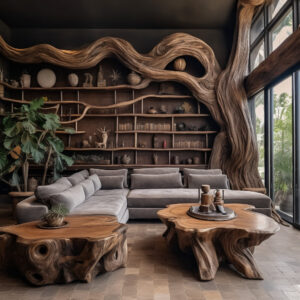Best Thermal Insulation Techniques to Enhance Your Home’s Comfort and Style
Creating an inviting and comfortable living space goes far beyond choosing the right sofa or the perfect shade of paint—it’s about designing a sanctuary that not only reflects your style but also caters to the practical aspects of living. Among these practical considerations, the implementation of thermal insulation techniques stands paramount. It ensures your home remains a haven of comfort against the chilling drafts of winter and the sweltering heat of summer. But how does one fuse functionality with aesthetics when it comes to interior design? Let’s explore this essential yet often overlooked aspect of home decor.
Introduction
Imagine retreating into a space that’s not only visually stunning but also exudes a sense of unparalleled comfort. This is the power of incorporating thermal insulation techniques into interior design. The purposeful selection of materials, strategic layering, and innovative design not only enhance the thermal efficiency of your home but also contribute significantly to its overall ambiance. In this era of climate consciousness coupled with a surge in home comfort, thermal insulation takes on an aesthetic dimension that complements the visual aspects of interior design. It is, undeniably, a cornerstone of creating a space that looks and feels exceptional throughout the seasons.
Key Elements of Interior Design
As we aim to elevate our interiors, it is imperative to recognize the building blocks that constitute a well-designed space. Here is a synthesis of key elements to keep in mind:
- Color Palette: The hues we select set the mood. From serene pastels to bold statements, colors encode ambiance and can impact the perceived temperature of a room.
- Furniture Arrangement: The layout of your furniture can dictate not only the flow of movement but also influence the thermal dynamics of the space. Proper placement can assist in optimizing warm and cool zones.
- Lighting: Strategic lighting transcends mere illumination; it sculpts the space, affects mood, and can even play a role in heating and cooling a room.
-
Textiles and Fabrics: The fabrics used in your space—from curtains to sofas—contribute to thermal insulation while adding texture and warmth to your design.
-
Accessories: The devil is in the details, they say. Accents like rugs, throws, and cushions can boost thermal comfort while echoing your design flair.
-
Sustainable Materials: Eco-friendly choices not only serve the planet but often come with naturally insulating properties.
-
Technology and Innovation: Smart home systems and innovative materials help to maintain the ideal temperature and enhance overall efficiency.
-
Window Treatments: Utilizing curtains, drapes, or blinds can drastically improve a room’s insulation against temperature extremes.
Tips for Thermal Insulation Techniques
- Select Dual-Purpose Furniture: Choose pieces that offer hidden storage for seasonal items or incorporate upholstered elements that add a layer of insulation.
- Consider furniture with built-in heat conductive materials for cooler climates.
-
Incorporate Thermal Mass in Design: Use materials like stone, ceramic, or concrete that can absorb and radiate heat, balancing indoor temperature swings.
-
Optimize Window Dressings: Invest in thermal curtains or honeycomb blinds to effectively trap air and insulate the room.
-
Think Layered Rugs and Carpets: They provide not only comfort underfoot but also act as a barrier to cold floors.
-
Embrace Greenery: Indoor plants can improve air quality and add moisture to the air, subtly regulating the indoor climate.
-
Harmonize with Ceiling Fans: Fans can be used to circulate warm air in the winter and create a cooling effect during the summer.
FAQ about Thermal Insulation Techniques
Question 1: How does color affect the thermal feel of a room?
– Answer: While color may not physically change the temperature, it can have a psychological impact. Dark colors tend to absorb more heat and can make a room feel warmer, while light colors reflect light, fostering a cooler sensation.
Question 2: Can the texture of a fabric influence insulation?
– Answer: Absolutely. Heavier, denser fabrics like wool or velvet offer better insulation as opposed to lighter textiles like linen or cotton.
Question 3: Are there specific plants that can help with insulation?
– Answer: While most plants can incrementally impact the microclimate, those with larger leaves or high transpiration rates add more moisture to the air, which can help with thermal regulation.
Question 4: How does furniture placement affect a room’s temperature?
– Answer: Furniture placement can obstruct or facilitate the flow of air. Keeping furniture away from radiators, vents, and windows ensures that heat circulates more effectively.
Question 5: What role does lighting play in thermal insulation?
– Answer: Apart from its visual impact, lighting can generate heat. Incandescent bulbs, for example, contribute to the ambient warmth of a space, while LED lighting stays cool, making it a better choice for warmer climates.
Incorporating these thermal insulation techniques isn’t just about achieving thermal comfort; it is about crafting an environment that stands the test of time and trends. The ability to stay warm in the plush dwellings of winter or cool in the airy sanctuary of summer defines the true meaning of a well-designed home. Remember, your space is a reflection of your personality and needs; with these insights, you’re well-equipped to make informed decisions that honor both form and function. Whether you’re undertaking a major renovation or a simple refresh, understanding and applying these principles will ensure that your home isn’t just a place you live but a space where you thrive.




